Chicago used to be a much dirtier place. This was especially true in the poor immigrant areas surrounding the Loop. 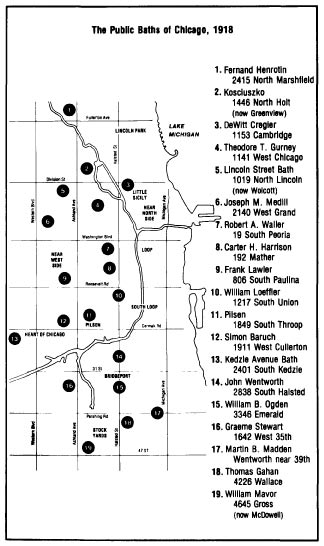 As families who had “made it” moved out to new areas on the edges of the city, they left behind neighborhoods where many households still lacked indoor plumbing, and thus a place to bathe. This problem remained unsolved until the Progressive Era, when many reformers pushed for the city government to build public baths to improve hygiene.
As families who had “made it” moved out to new areas on the edges of the city, they left behind neighborhoods where many households still lacked indoor plumbing, and thus a place to bathe. This problem remained unsolved until the Progressive Era, when many reformers pushed for the city government to build public baths to improve hygiene.
The Municipal Order League, a women’s reform organization, led the campaign for public baths in Chicago. With the support of other reformers and the press, Mayor Hempstead Washburne and the city government joined the cause. Finally, the first public bath was constructed by the city and opened in 1894 on the Near West Side near Hull House.
Chicago built 19 public baths between 1894 and 1918. Two other baths were also provided inside water pumping stations for men only, bringing the total to 21. Patronage declined over the years, with laws requiring indoor plumbing facilities in apartments making bathhouses less essential. The city started closing the public baths after World War II. The last one open was the Robert A. Waller public bath at 19 S. Peoria, built to serve the Madison Street skid row district. It closed in 1979, after the heart of skid row began to be demolished for the Presidential Towers development.
Chicago’s public baths were simple and utilitarian. Most were named after notable public officials. Separate facilities for men and women were not provided; they were simply accommodated for on different days. A waiting room was usually provided in a small outcropping to the side of the main building. The early bathhouses were built with very little ornament with the exception of the name of the bath above the entrance. Later bathhouses appear to have been built with more design in mind, but they were still very simple overall.
Of the nineteen bathhouses built by the city, four still exist: three in West Town and one in Pilsen. All have since been converted into private residences.

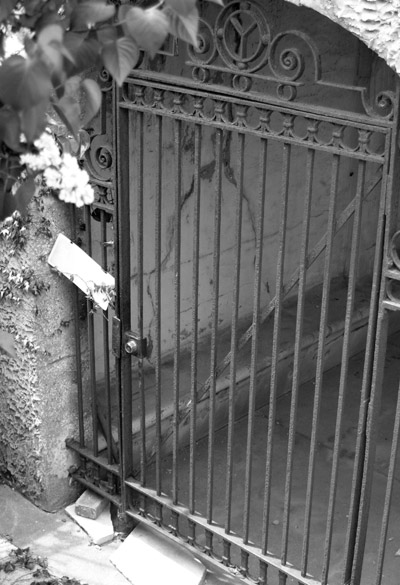
The Kosciuszko Bath, located at 1446 N. Greenview, opened in 1904. This is by far the most intact extant bath, notable because it is the only one that still has its original waiting room area off to the side. The details are unmistakably Municipal, as the “Y” Devices are prominent but un-embellished. There is one above the entrance to the waiting room (above right), as well as in the design of the wrought iron gate (left).
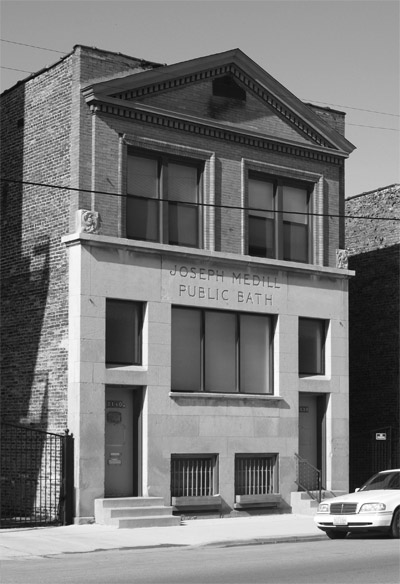
|
|

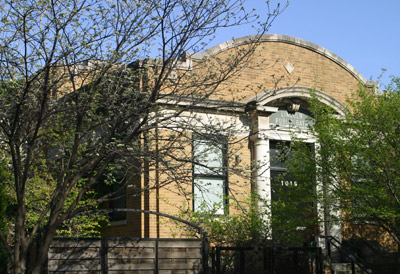 Left: Illinois Historic Preservation Agency
Left: Illinois Historic Preservation Agency
| The Lincoln Street bath is located at 1019 N. Wolcott, which was originally named Lincoln Street in the area. This bath, the second to last to be built, opened in 1918. One can definitely see the progression in bathhouse design here. This bath is only one story high and is a bit more ornate than earlier versions. The waiting room was probably off to the side behind the fence. A sign above the door announces the name of the bath on a familiar Park District sign, a remnant of the later era when they operated the bathhouses. |
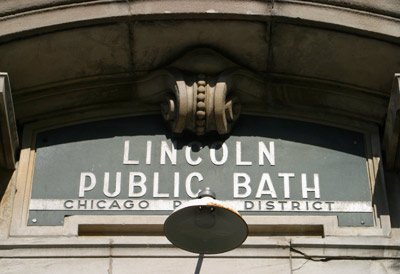 |
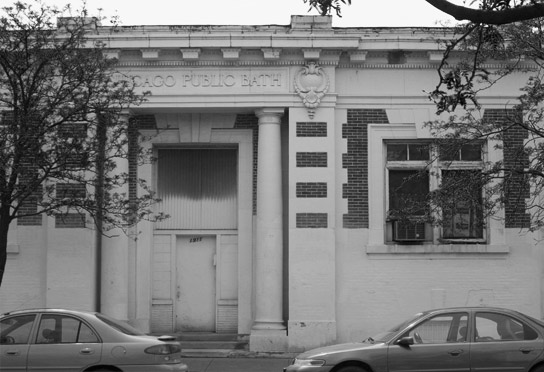
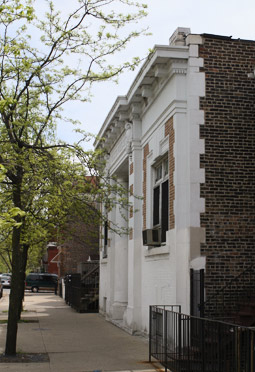
|
The Simon Baruch bath opened in 1910 and is located at 1911 W. Cullerton. It appears somewhat similar to the Lincoln Street Bath, as it is from the later era of bathhouse construction. A waiting room is not readily apparent from the exterior; perhaps it was incorporated into the general design of the building. Prussian/Polish immigrant physician Simon Baruch is considered the inventor of the bathhouse. In the late 19th century, he used his own funds to build public bathhouses in tenement districts of New York City. Interestingly enough, this bathhouse does not feature Baruch’s name on the facade; instead it reads the generic “Chicago Public Bath.” |
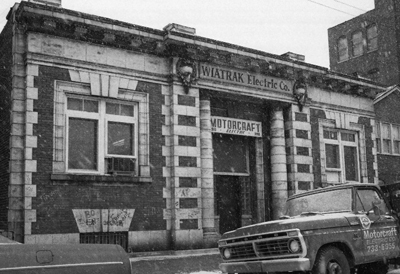 Illinois Historic Preservation Agency This 1970s photo shows the bathhouse in use as a small factory or warehouse. Currently, it appears to be in use as a private residence.
|
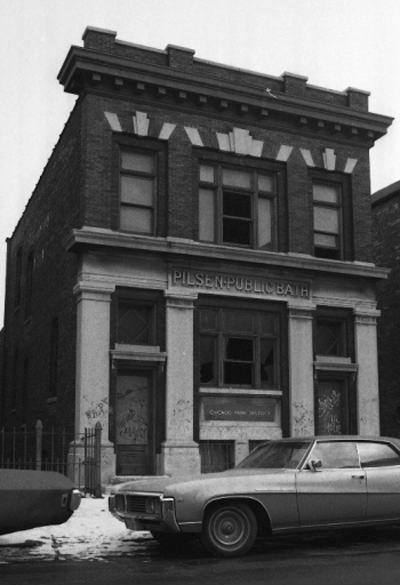
 Illinois Historic Preservation Agency
Illinois Historic Preservation Agency
Right: Another bathhouse in the style of Medill and Kosciuszko. Named after Chicago’s first mayor, the William B. Ogden bath opened in 1906 in Bridgeport at 3346 S. Emerald. It appears to still be in good shape and in use as a private residence in this 1970s photo. Unfortunately, it has been demolished since then.
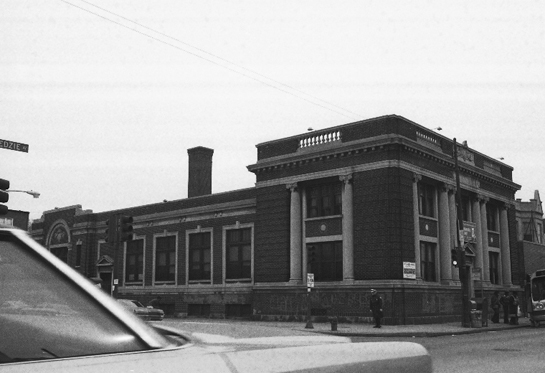
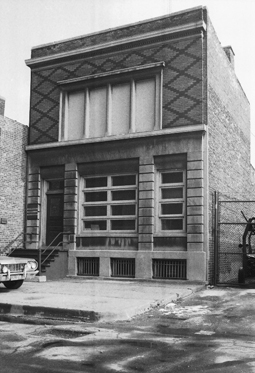 Illinois Historic Preservation Agency
Illinois Historic Preservation Agency
Left: If this bathhouse looks much bigger and different than all the others…that’s because it is! One of the last bathhouses to be built, the Kedzie Avenue bath was built in 1918 at (fittingly) 2401 S. Kedzie. Its much bigger size can be attributed to the fact that it was also an infant welfare station, and its waiting room could double as an auditorium. This photo shows that it was still in relatively good shape, though it has since been demolished.
Right: The Robert A. Waller bath opened in 1901 at 19 S. Peoria. It was one of the earliest baths to open, and the oldest shown on this page. Its age may explain why it looks rather different when compared to later bathhouses. The name of the bath is nowhere to be found on the building, unless it was removed by the time this photo was taken in the 1970s. This bath served the Madison Street “Skid Row” district, and was the last public bathhouse in the city to be closed, in 1979.
- The Municipal Device
- Fire Insurance Patrol Stations
- Disused Fire Stations Part 1 – 19th Century
- Disused Police Stations
- Chaddick Institute Webinar on Wednesday, May 12, 2021: Illinois Center & Lakeshore East: Rail to Real Estate

 The Joseph M. Medill bath is located at 2140 W. Grand, and opened in 1906. It is similar to the Kosciuszko bath, though the waiting room area that was presumably off to the side is missing. An inscription on the side of the building reads “Department of Health,” the original operator of the baths. The Park District was later given the task of operating the baths.
The Joseph M. Medill bath is located at 2140 W. Grand, and opened in 1906. It is similar to the Kosciuszko bath, though the waiting room area that was presumably off to the side is missing. An inscription on the side of the building reads “Department of Health,” the original operator of the baths. The Park District was later given the task of operating the baths.

